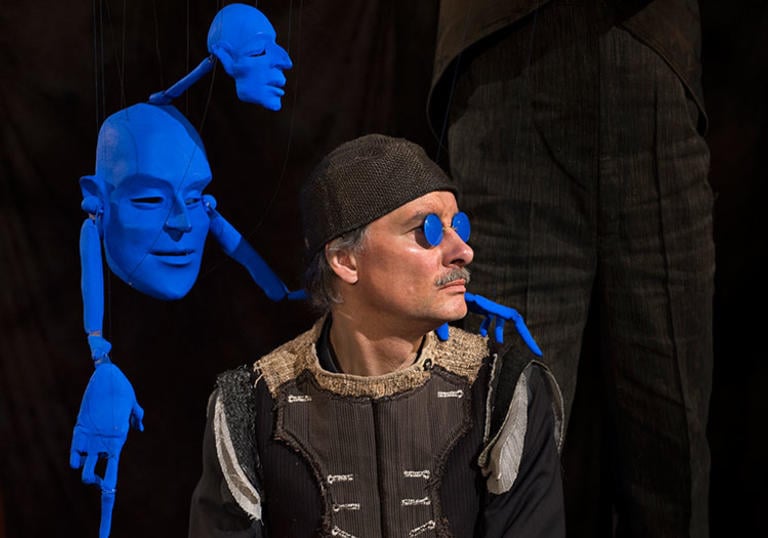One of the world’s most distinguished creators of puppet theatre, Frank Soehnle and his productions have added to the lustre surrounding this branch of the performing arts in the twenty-first century. His aesthetic is unique, always the hallmark of a true artist; his techniques of craftsmanship and staging, his company’s performances in terms of their poetry and precision of movement and manipulation are superb; his choices of a dramaturgy which integrates sculpture with movement, music with drama, the creepy with the comic, the refined with the coarse are all the product of an original vision.
The company’s base, Tübingen, is a town some 30 kms. from Stuttgart, where he was born. Co-founder of figuren theater tübingen, is Karin Ersching, performer, puppeteer, director, lighting designer and tour manager. She worked in special education from 1987-93, and has independently given guest performances and workshops in many different countries. She also makes puppets and teaches manipulation to students.
The Wunderkammer itself is like a strange museum…
This year the company is back in the London International Mime Festival, where it has been three times before, with Flamingo Bar, Nachgesichter or Night Visions, salto.lamento (one of my all-time favourite theatre productions) and now Wunderkammer, a chamber of wonders or, as the programme has it, a Cabinet of Curiosities.
The Wunderkammer itself is like a strange museum where a number of fantastic objects, artistic, scientific and natural, are operated by stringed controls and given life by three expert marionettists. These puppeteers have come together in a common desire to pay homage to the doyen of the European marionette, the late Albrecht Roser. Each of the three was a student and friend of Roser, each is director of her/his own company: Frank Soehnle himself, Alice Therese Gottschalk of FAB Theater, and Raphael Mürle of Figurentheater Pforzheim; each studied and/or taught in the Hochschule für Musik und darstellende Kunst, the Higher School of Music and the Performing Arts in Stuttgart, in the puppetry department founded by Albrecht Roser in 1983. Roser was introduced to Soehnle when he was only 15, and acknowledges him as his inspiration and generous mentor until his death in 2011.
Soehnle is fundamentally a modernist, an admirer of the Dadaists and the Surrealists
Another aim of the creative team was and is a determination not just to keep the employment of the stringed puppet alive but to demonstrate that it can be as contemporary and experimental as any other type. The Tübingen company has been successfully accomplishing that for some years.
Soehnle is fundamentally a modernist, an admirer of the Dadaists and the Surrealists. His figures, always made by him, are like no others. They are often insubstantial, ghostly, sometimes made of ephemeral materials. They are ‘genderless hybrids, embodying transience and death’, although the characters can be as comic as they are sinister – defined, Soehnle says, as much by their movements as by their role. With string puppets the movement is dictated by the marionette, which may be tiny or gigantic. At some stage of their animated life they are inclined to become independent of their maker, seeming to be manipulating the puppeteer, not the other way round. The performer needs to find the figure’s ‘centre’, on which he or she goes to work to achieve the professional precision so important to puppet performance, within the choreography of the whole.
The shows are nearer to dance than drama. They may be based on a literary text – by Kafka, Chekhov or Čapek for example. The literary story serves as the structure of the show but Soehnle captures the language in atmospheric stage pictures rather than speech. There are exceptions, for instance in one production, Gabriel García Marquez’ story of The Very Old Man With Enormous Wings, presented by the Tübingen company as With Enormous Wings, a narrator was pivotal to the action. For the international tour each actor chosen to play the part was a native speaker of the country where it was shown. There is no permanent group of players: a special team is chosen for each show, sometimes four or five, sometimes only one. Soehnle calls himself the ‘soul’ of the work, where sculpture and music are essential elements, but his own fantastic imagination always at its core.
In the making of Wunderkammer the whole company played a part. The concept was inspired and framed by the music of Bradley Kemp, a jazz musician brought over from New York, who supplemented the compositions of Michael Wollny and Tamar Halperin. Within this framework the creation of the show was an open collaborative process, developed by a company of artists incomparably rich in talent and united in their creative aim. It has resulted in a beautiful and intriguing series of scenes in which stringed artefacts are animated in various modes and moods, both serious and comedic.
Few companies have been chosen for the London International Mime Festival four times: it is proof of the high regard for Frank Soehnle’s productions held by the brilliant Seelig/Lannaghan partnership, as excited to present Wunderkammer as we are to see it.

